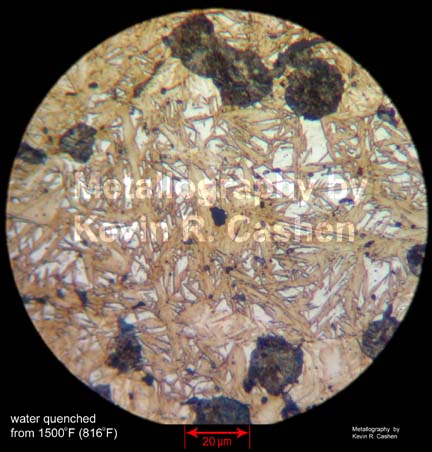Me2, you do offer some industrial examples of mixed structures that give legitimacy to the concept. One needs to remember what newer knifemakers will take from the conversation. An odd thing I have found about newer knifemakers, when they are trying to find support to their plans and thought patterns, is the ease with which they can take almost any exception to the rule and apply it as if it were a rule, trust me, I know I was there once myself.
Yes there are a few exceptions where industry can use mixed phases to achieve the properties they are looking for, but for most properties the more homogenous the structure, the greater the gains in the target property. Strength is one where this is prevalent. Generally a duplexing of phases is a compromise to try to get some benefit from two properties at once.
If it is not a direct conflict of properties, such as pearlite in martensite, i.e. having hardness countered by a softer phase, it can often be the interface of two distinctly different crystalline orientations where problems arise. Even within a homogenous phase this is the case, for example fractures in totally martensitic steel travel along the grain boundaries, the interfaces between one crystalline orientation and another.
An even better example, and one that most folks don’t get the joy of experiencing, is the rather dynamic interface between martensite and its parent austenite. During the Bain strain of habit plane formation, in the making of martensite, the steel is miserably brittle. If you were to whack a blade or kink it too tightly in a bend, when it is around M50% you would be shocked at how unstable it is (please don’t ask how I know this

).
The most predictable way for the average maker to take advantage of duplex structures is to avoid them in the micro sense and work with them in a macro sense. The example I am thinking of here is a martensite edge with a pearlite spine, this permits maximizing of the martensitic strengths. However even here it is the interface that is an issue. One of the main reasons you will find mentioned for the development of “ashi” is to limit fracturing that wants to run along the martensite/pearlite interface. And I have seen suguha type blades that did have their edges decide to depart the spine in quenching.
So one can see the complications that arise even in the exceptions, but for the new guy this topic is rarely about duplexing acicular bainite with martensite. The new guy is asking a much more basic question- “If I am shooting for 59HRC after I am all done, why do I need to quench it any harder than 59HRC?” To this I have an equally basic answer in the form of a question- if a farmer’s crop will only be 6” tall after harvest, then why does he have to wait for it to grow much taller than 6” to harvest it? While it sounds like a stretch there really isn’t much difference, a farmer wants his crop as high and full as it can get before the harvest it to maximize his yield, the knife makers wants his steel as martensitic as it can get before he tempers it, to maximize its strength.
Pearlite on a cutting edge stinks out loud. It is contrary to almost every property you want for a cutting edge, and every point of HRC you drop from the as-quenched maximum equals pearlite formation in the steels we forgers typically use. Now what is the difference if we are dropping that strength back to 59HRC anyhow?
Let’s look at just one aspect- carbide. The carbide in pearlite is courser and lamellar in nature, not particularly good for a very stable fine edge. Stable edges are made from very evenly distributed fine carbide, the finer the better. Carbides found in tempered martensite are so fine you cannot even see them with an optical microscope, and they are everywhere! They precipitate from every point in the martensitic matrix. This is why martensite rules for ultra-fine cutting edges, its homogeneity and fine structure allows it to get shaper and hold that shape better under pressure. Pearlite doesn’t sharpen as well and can’t hold the shape it does take. A pearlite colony formed in insufficient quenching can be huge, such as here:

Some of those blobs are almost 20 microns across, and that was from a water quench (the faster the quench the smaller the size of pearlite colonies as well as the carbide spacing in them). To effectively shave hair, an edge should be under 1 micron. So an edge loaded with pearlite colonies would have sections of inconsistency and weakness as much as 20 times greater than what we often accept as a standard of sharpness. Under the microscope these edges look more like rows of rocks than a cutting edge. This gets by some folks because the ragged edge that it can form will rip through paper and other items very aggressively, but it simply is not as sharp and stable as a fully martensitic edge that was tempered.

